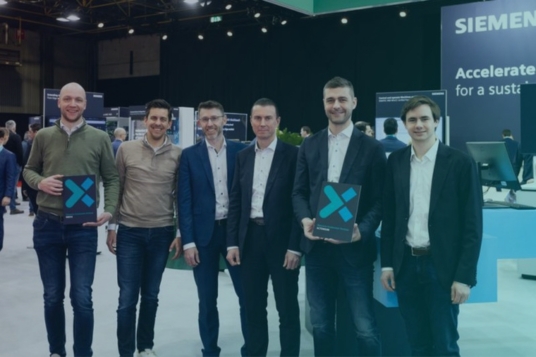News & Blogs
Stay updated with the latest news, insights, and expert blogs from Emixa. Explore industry trends, digital innovations, and company updates all in one place.

- PLM
- Teamcenter
Teamcenter - Next Level Documentation Management
Would you rather your engineers just focus on technical work, or have them spend needless time searching through folders to locate documents? If you do not work in a PLM (Product Lifecycle Management) environment, it’s difficult to capture these documents and stick to the required formats. The PLM environment oversees the entire lifecycle of a product, from concept and design to production and product launch. This product life cycle includes different types of documentation such as: CAD drawings, test procedures, reports, marketing material, or user manuals. Product documentation is an essential component. It therefore must be: consistent with the product design and configuration, available on time, and in accordance with the company's documentation guidelines. The Teamcenter® document management solution can help you with this. Document management is much more than storing and sharing documents! Teamcenter® enables document management capabilities that operate within the PLM environment. This solution makes the standardisation and management of documents and processes easier. This, in turn, increases productivity and reduces cycle times. The advantages of Siemens Teamcenter® Document Management Accelerate time-to-market Increase productivity Improve product launch Reduce document confusion Unlike previous, standalone document management systems, documents that are managed in Teamcenter® link to all relevant parts, products, as well as other documents. In the event of any changes that are made, the impact on your document can quickly be identified. It is crucial that the correct version is used. This way you never miss important information and documents are always up to date! Teamcenter® incorporates document management capabilities throughout your product development environment: Working with templates Teamcenter predefines templates for different document types. For example, when creating a new document, Teamcenter will always select the correct template. This guarantees that the correct format will be used throughout the organisation. Synchronised data It is also possible to synchronise information contained in articles, or parts lists, for example, between all documents stored in Teamcenter. If the information in the document or in Teamcenter is changed, it will automatically be updated. This allows you to manage the information in one place and use it in multiple locations automatically, preventing costly errors in the process. Automatic PDF Another advantage of Teamcenter is the ability to view files in neutral formats. Any file type can be automatically opened in PDF to add comments, share with customers or associates, and verify authenticity using a digital signature without disclosing intellectual property rights. Secured documents Teamcenter provides the ideal all-in-one solution you need for securing access, modifying, and removing documents. The checkin and checkout option prevents multiple employees from overwriting the document at the same time. Integration with Office 365 allows different colleagues to work on the same document. Finally, the rights of access to documents can be set for each role, group or project. Are you looking to improve document management in your product development process? Contact us and request a free live demo with one of our consultants.

- Siemens
- Digital Transformation
Emixa: Leading the Digital Revolution with Siemens Xcelerator
In an era where digitalisation and technological innovation are pivotal to industrial progress, Emixa and Actemium stand at the forefront of a groundbreaking development. These two industrial technology powerhouses have joined forces with Siemens to demonstrate the benefits of the online open business platform as the first Belgian Siemens Xcelerator partners at Indumation. This collaboration marks a crucial step forward in the faster development, sharing, and scaling of digital solutions, an ambition crucial for the future of the industry.

- SAP
Dimensys SAP Ambassador of the Year
We congratulate Dimensys on their SAP Ambassador Award of the Year, which they received last week during the SAP Partner Awards 2022. The SAP Ambassador Award puts the most outstanding achievement in 2022 in the spotlight. The jury report concluded: “Dimensys played a crucial role in winning over a client based on exceptional commitment and expertise. In addition, they have demonstrated the undeniable importance of what good cooperation between SAP and the SAP Partner community can deliver. They worked together with SAP for two years on a deal cycle that resulted in the largest indirect deal ever: a RISE with SAP/4HANA Cloud deal with one of the largest engineering, construction and operating companies in the Netherlands.”

- SAP
- S/4HANA
- +1
Emixa & Croonwolter&dros Celebrate SAP S/4HANA Implementation Success
EC&O Leader Replaces Aging ERP System, Completing Full-Scale Digital Transformation to Enhance Efficiency and Scalability.

- Management Consulting
- Consumer products & retail
- +1
How to Future-Proof your IT as a Retailer
Imagine this: a customer walks into your shop, pulls out their smartphone, and expects to switch between your online and physical offerings seamlessly. This is the new reality that retailers are facing today. Consumers want convenience, speed, and a seamless experience, no matter where they are. But how do you, as a retailer, stay competitive in a world where technology is evolving at lightning speed?

- ERP Software
VolkerWessels Telecom is Ready for the Future with a New ERP system
Live! VolkerWessels Telecom is prepared for the future with a brand-new ERP system. The company now has more insight into and control over its many installation and management projects and service contracts. Project leaders Maarten van Welsem, Tinyce Wassens, and managing director Adem Karademir explain what was involved in this monster job.

- Mendix
Manufacturing Menu: Enhance Your Business with Mendix Supplier Portal
Manufacturing companies operate in a complex and dynamic market landscape. One of the significant challenges is effectively managing relationships with suppliers, especially when dealing with complex products requiring various raw materials, materials, or components. Prices and the availability of raw materials fluctuate, while suppliers come, go, or change.

- SAP
- S/4HANA
Future-Proof Project Management: Emixa Prefab for SAP S/4HANA
Emixa has developed specialized SAP add-ons designed for project-based organizations, with a strong focus on the construction and installation industries. Although our Prefab SAP solution was introduced decades ago, it remains highly relevant today, especially with several exciting new developments on the horizon.

- IT
- IT Strategy
How Do Trends in the Construction Industry Affect Your Organisation?
The construction industry is evolving rapidly due to technological innovations, sustainability requirements, and new regulations. Building Information Modelling, modularity, circularity, inner-city construction, net-zero building, and the war for talent—these are just a few of the trends you can't afford to miss. How will they affect your organisation? In this Better Building blog, you’ll discover how your organisation can make informed decisions using Emixa's Competing Interests Model.